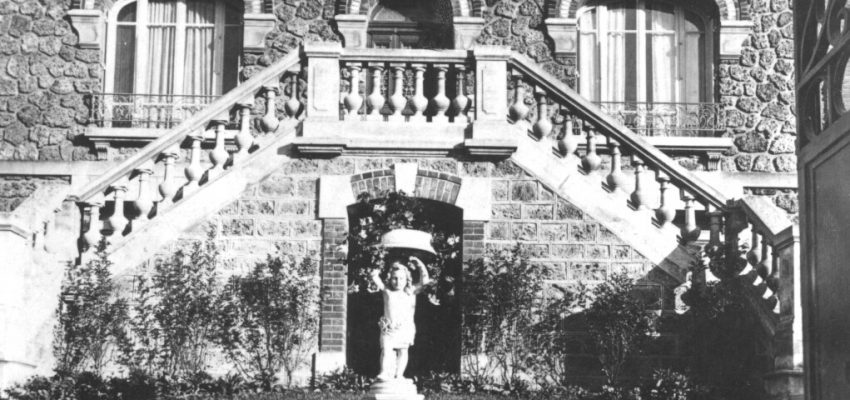1922
In dit jaar is Murshid driemaal in Nederland:
- van 20 tot 30 januari in combinatie met een reis door België,
- van 1 tot 16 april
- van 1 tot 16 september voor een verlengde Nederlandse Zomerschool in Katwijk aan Zee.
Ameen Carp vermeldt een bezoek van Hazrat Inayat Khan in februari 1922, waarbij hij lezingen geeft in Amsterdam, Arnhem, Nijmegen en Haarlem. [1]
In februari trouwen Sirdar van Tuyll van Serooskerken en Henriëtte (Saida) Willebeek Lemaire. Ze gaan wonen in huis Van Melskade 5 in Katwijk aan Zee. [2]
In het maartnummer van de Sufi Quarterly worden twee Nederlanders met hun functie binnen de Soefi Beweging vermeld:
- Baron Van Tuyll, National Representative, Holland.
- Mr. F. E. Farwerck, Emmastraat 58, Hilversum, Holland. Secretaris van het Nationaal Comité. [3]
Op 16 maart wordt het centrum Den Haag (Anna Paulownastraat 78) geopend in het nieuwe en definitieve woonhuis van Sirdar van Tuyll. De van Melskade 5 in Katwijk aan Zee wordt als tweede residentie door het echtpaar nog een paar jaar aangehouden.
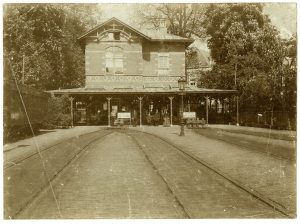
Anna Paulownastraat 78 in de tijd dat het pand nog dienst deed als tramremise
Van 1 tot 17 april bezoekt Hazrat Inayat Khan Nederland voor een ‘Lecture Tour’. De Sufi Quarterly van juni 1922 bericht het volgende over dit bezoek:
Report of Dutch Section.
“From the 1st of April -till the 17th Pir-o-Murshid visited Holland and lectured in several towns. In the Hague and in Amsterdam he spoke four times in public, in the latter town also giving a most inspirational address on Art in the Art-Circle “Petrucci,” delivered at an Exhibition of very beautiful Chinese Art. At the University towns of Delft and Leiden the Murshid was introduced to the student circles, and at Leiden hk: was the guest of a Society of Mohammedans from Dutch-India, to whom he gave an address on the Life and Teaching of the Prophet. In the town of Nymegen he repeated this lecture and on the day following gave one on the subject of the Christ which made a deep impression upon all who heard it. At every town Pir-o-Murshid’s visit was all too short; but in spite of this the response was very real and much good seed was sown.”
We hebben een ooggetuige-verslag van iemand die in april 1922 een lezing in Arnhem bijwoonde:
“Het was in het jaar 1922. Ik woonde toen in Hattem (…). Zo kwamen we in Arnhem in Musis Sacrum, waar Murshid Hazrat Inayat Khan in een zaaltje zou spreken voor een kleine groep mensen. Men wees mij een plaats op de voorste rij. Terwijl wij daar rustig wachtten, voelde ik plotseling een fysieke pijn in mijn hart en omziende zag ik Murshid, die door het zaaltje schreed en die mij aankeek. Een machtig, groot gevoel doorstroomde mij. ‘t Werd heel stil van binnen en heel mijn wezen zei ‘Ja’ op dit ontmoeten. (…).Bij het verlaten van het zaaltje werd me gevraagd, of ik soms een onderhoud wenste met de spreker. ‘Graag’, zei ik en zo stond ik den volgenden morgen op de stoep bij de familie Van Ingen, waar Murshid logeerde.”
Dit verslag is van Hayat Rahusen, de latere echtgenote van Nico (Salar) Kluwer. Haar zus was toen al mureed.
Het is tijdens dit bezoek aan Nederland dat Murshid per post een Soefinaam aan Nelly Egeling geeft: Fazal Mai (blessed mother).
De eerste Zomerschool in Suresnes
De Nederlandse welgestelde weduwe Nelly (Fazal Mai) Egeling woonde na de dood van haar man een aantal jaren in Lausanne, Zwitserland. Daar leerde ze ook Hazrat Inayat Khan kennen tijdens een van zijn lezingen. Rond 15 april arriveert ze in Suresnes, waar ze bij de familie van Hazrat Inayat Khan in komt wonen in het huis Fazal Mansil (Blessed House) dat ze eerder voor de familie van Hazrat Inayat Khan gekocht had. Ze wordt hartelijk ontvangen door Begum en de kinderen. Op 5 juli wordt ze daar door Hazrat Inayat Khan tot eerste Nederlandse Cherag geordineerd.
Op diezelfde dag, 5 juli, wordt in Suresnes Viladatdag gevierd, de geboortedag van Hazrat Inayat Khan. Eqbal Dawla van Goens is bij de viering aanwezig zoals blijkt uit een zin uit de Sufi Quarterly van september:
The above address (by Barones Van Hogendorp, PK) was followed by the greetings and good wishes from Holland, given by Mme. van Goens.
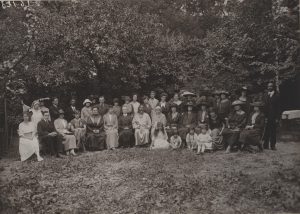
Zomerschool van 1922, beperkt in omvang.
Zittend vierde van links: Shadbiy van Goens, vijfde van links: Eqbal Dauwla van Goens – van Beyma
De eerste zomerschool in Nederland
Van vrijdag 1 tot en met vrijdag 15 september. Hazrat Inayat Khan bezoekt Nederland voor een korte zomerschool in het huis van Van Tuyll in Katwijk aan Zee (Villa Honk -onder soefi’s ook Dawlat Khana genoemd- aan de Van Melskade 5, thans Zuidboulevard). Tijdens deze periode zegent hij een plek in de duinen bij Katwijk aan Zee en noemt de plek ‘Murad Hassil’ (wens vervuld). In 1970 zal hier de huidige Universel verrijzen.
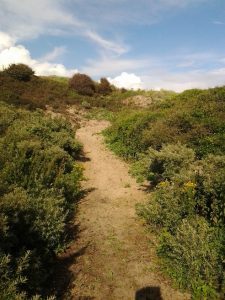
De plek Murad Hassil in de duinen bij Katwijk aan Zee is ook heden ten dage nog te bezoeken.
In 1970 verrees hier een Universel (soefitempel) met dezelfde naam
In ieder geval zijn aanwezig tijdens deze zomerschool [4]:
- Sirdar en Saïda van Tuyll van Serooskerken,
- Salima van Braam,
- C.A. Wegelin,
- E.W. Hendrikse (maakte een klein deel van de zomerschool mee, maar heeft Hazrat Inayat Khan daar niet ontmoet),
- Mevrouw Cnoop Koopmans – Waller en haar pleegdochter,
- Bakhtavar Lugt – Baak,
- Bhakti Eggink – van Stolk (zuster van Sirkar van Stolk),
- Joanna van Ysendijk.
Daarnaast was Sophia Saintsbury Green aanwezig. De lezingen die Hazrat Inayat Khan hield tijdens deze verlengde zomerschool, zouden later gebundeld worden onder de titel: The Inner Life (Het innerlijk leven).
Deze periode is tevens belangwekkend omdat de eerste Universele Eredienst in Nederland wordt gehouden op zondag 3 september. Een week later, op 10 september, vindt er weer een Universele Eredienst plaats.
In de Sufi Quarterly van december 1922 lezen we:
SUMMER SCHOOL IN HOLLAND,
“The first fortnight of September proved of special interest to the Order, for it saw the establishment by Pir-o-Murshid in Holland of a Sufi Summer School. This was the first summer school in connection with the Order to be held in that country, and its value was felt to be so great, so unique, that it is the most earnest wish of all who were privileged to take part in it that it may be held annually, so that its inspiration may be shared by other members and friends.
The place chosen was the charming seaside village of Katwyk (near Leiden), beloved of artists, for here Baron and Baroness van Tuyll very kindly placed their house, Dowlat Khana, which overlooks the sea, at the disposal of the Order for the entire series of meetings, besides acting as host and hostess to Pir-o-Murshid and Miss S. E. M. Green, Khalifa. A group of the members had joined together in taking over a boarding-house in the village, and here they made their own arrangements as to meals and social life,
Mrs. Leembruggen kindly consenting to become responsible for its superintendence.Prior to coming to Katwyk, Pir-o-Murshid had given a lengthy series of lectures at Suresnes, which had been attended by Dutch, Swiss, Poles, Russians, French, Americans, and English ; and at Katwyk, the nationalities represented were Dutch, French, Belgian, American, and English. During the week-ends many members and friends took advantage of the opportunity to come from the Hague, and other more or less distant places, in order both to attend the meetings, and be present at the services of the Church of All.
On each week-day, in the large and beautiful studio at Dowlat Khana, Pir-o-Murshid gave two lectures, one in the afternoon and the other in the evening; and on each Sunday a service of the Church of All was held in the morning. This was the settled programme, but in addition thereto Murshid devoted hours daily to interviews (some on the sea-shore) with members and friends of the Order, and inquirers.
The lectures consisted of two series, those in the afternoon dealing with “Problems of the Day,” and those in the evening with ” The Inner Life.” Questions were permitted at the close of each afternoon lecture, and in this way a great many interesting points covering an astonishingly wide field of inquiry were spoken about and explained.
In the lectures on ” Problems of the Day ” Murshid spoke of such things as the artificial nature of the life led by man to-day and its consequences, the necessity for possessing a right mentality, and various moral problems ; but most of the series were definitely concerned with the subject of Brotherhood, and the need, if the ideal was effectively to help the troubled world of to-day, that it should be free from all limiting distinctions and differences, and should embrace the whole of Humanity without qualification. One point in this connection, which excited a good deal of thoughtful interest, was Murshid’s emphasis of the desirability of the children of to-day having this lofty Brotherhood ideal impressed! upon them directly their intelligence began to develop; of the need there was for teaching the little ones that they were not only the brothers and sisters of members of their own family, but the brothers and sisters of other children as well. In speaking of such fateful world- interesting events as international conferences; he said how great was the need of men who represented, not so much the interests of a particular nation or race, as disinterested justice, for only by the application of this could the national and racial hatreds, bitternesses, and disappointments, be really settled.
The evening lectures on “The Inner Life” will never be forgotten by those whose privilege it was to hear them. Each was preceded by a silence of about half-an-hour. The whole atmosphere was charged with a singular harmony and peace, and the lectures themselves were full of beauty and inspiration.
The meetings came to a close on Wednesday, September 13th, which was the twelfth anniversary of the day on which Pir-o-Murshid sailed from India to bring his message to the Western world. In the evening, instead of the usual lecture, Miss Green spoke with deep feeling of Murshid’s devotion to the cause for which he stood, and the blessing he had conferred on all who had responded to his teachings. Baron van Tuyll and Mr. C. A. Wegelin also expressed, on behalf of the members at Katwyk, their profound appreciation of the inspiration which the Summer School had been to them. Murshid, in reply, spoke of the spread of the message and the encouragement he had received in his great task from the faithfulness and responsiveness of those around him.
There were very good attendances at the Church of All on the two Sunday mornings. On each occasion Miss Green conducted the service and Murshid gave an, address.
Not the least pleasant feature of the School was the friendly association of the members. All felt that a real brotherly spirit existed between them, a spirit which completely removed the barriers which usually stand between people of different nationalities. Special gratitude was felt by the visitors for the warmth of the welcome and the unvarying kindness displayed towards them by the Dutch members without exception.”
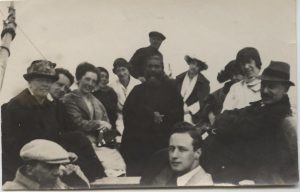 Een groep Nederlandse mureeds van het eerste uur,
Een groep Nederlandse mureeds van het eerste uur,
samen met Murshid tijdens een boottochtje in Katwijk aan Zee.
Hazrat Inayat Khan verplaatst dit najaar de Headquarters (IHQ) van de Soefi Beweging in oprichting van Londen naar Geneve.
“22 December 1922: Baron van Tuyll (Holland) has been made Cherag of the Church of All.” [5] [6]
Een andere prominente Nederlandse Soefi van de begintijd staat op het punt zijn eerste ontmoeting te hebben met Hazrat Inayat Khan. Apjar van Stolk, die in 1922 aan het kuren is in Zwitserland, hoort via een vriend dat Hazrat Inayat Khan in januari 1923 Nederland zal bezoeken. Eind 1922 komt hij speciaal naar Nederland om deze Indiër te ontmoeten:
“In de herfst van 1922, toen ik in Zwitserland was om behandeld te worden voor een ziekte (tbc, PK) waar ik de afgelopen drie-en-een-half jaar last van had, schreef een vriend van me een brief. (Later zou hij mij bij Hazrat Inayat Khan introduceren. ) Geïnteresseerd als ik was in geestelijke zaken, dacht hij dat ik wel graag zou willen weten dat er een opmerkelijke leraar neergestreken was in Frankrijk, in de buurt van Parijs. Hij zond me de naam van deze leraar en drong er daarbij op aan “contact op te nemen met deze man indien mogelijk. Zorg dat je ondertussen een exemplaar in handen krijgt van een boek van hem, getiteld ‘In een Oosterse Rozentuin”. (…)
Het was in december van datzelfde jaar – december 1922 – dat ik hoorde van Hazrat Inayat Khan’s op handen zijnde bezoek en lezingen in Nederland. En dit was het moment waarop ik hem ontmoette. (januari 1923, PK) (…)
De indruk die op mij gemaakt werd toen Hazrat Inayat Khan de kamer binnenkwam was zo krachtig dat ik het nooit zal vergeten. ‘Een leraar van enorme spirituele statuur’, was hoe een vriend deze bijzondere Indiase filosoof had omschreven en ik had de reis van Zwitserland naar Nederland speciaal gemaakt om hem te horen spreken. Maar ik had me niet gerealiseerd, tot mijn aankomst in Nederland, dat ik hem persoonlijk zou ontmoeten. Mijn vriend had alles van tevoren geregeld; de ontmoeting zou plaatsvinden in de Frederik Hendriklaan in Den Haag en ik had er van tevoren naar uitgekeken met een ongeduldig verlangen. “ [7]

